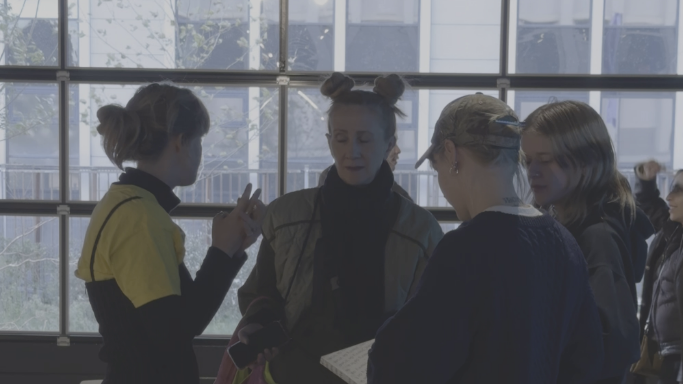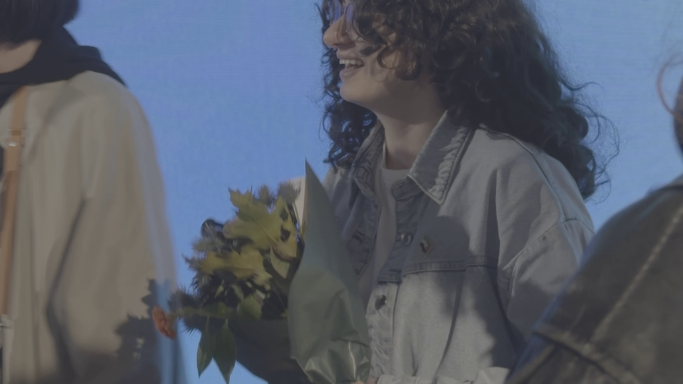STRP selects three winners for the Young ACT Award to help art academy graduates launch their careers as emerging artists.

The switch from being a student at an art academy to becoming a professional in the field can be challenging. STRP Young ACT Award provides a platform for artists to expand, realise, and ultimately present their graduation project as part of STRP’s 2026 exhibition ‘Big Energy, Slow Futures’.
This year, three winners were selected by the jury consisting of STRP’s Artistic Director and the STRP Young Advisory Board. They receive a project budget, artistic and production guidance, and the chance for the selected artists to become part of a growing network of creatives and collectives.
Let’s have a look at the winners and dive into their work together.
Sara Ballout
NETWORKS OF NECESSITY
As a Lebanese artist and designer based in the Netherlands, Sara Ballout investigates how people adapt to the collapse of infrastructures through collective, material, and social practices. By drawing on personal experience and regional research, her work results in tangible, interactive experiences that question how resources are accessed when energy becomes a tool of control.
Through ‘Networks of Necessity’, Ballout explores how communities in Lebanon and the Middle East respond to energy scarcity as a result of crisis and war by creating their own grassroots adaptation of informal, decentralised networks. In her selected work, a Lebanese electrical pole becomes an interactive installation where visitors can flip circuit breakers to activate or shut down soundscapes and visuals. Together with other interactive elements, Ballout’s installation shows that when state systems collapse and energy becomes a tool of control, empowerment can be found through everyday acts of resistance and community resilience.
Through this installation, visitors experience the tension between large-scale and centralized energy systems in opposition to slower, grassroots practices. Respectively embodying the ‘Big Energy’ and ‘Slow Futures’, Ballout’s work shows how, at a time of power abuse and control, people invent slow futures as a form of resistance by collectively slowing down and looking for creative solutions.
As a Lebanese artist and designer based in the Netherlands, Sara Ballout investigates how people adapt to the collapse of infrastructures through collective, material, and social practices. By drawing on personal experience and regional research, her work results in tangible, interactive experiences that question how resources are accessed when energy becomes a tool of control.
Through ‘Networks of Necessity’, Ballout explores how communities in Lebanon and the Middle East respond to energy scarcity as a result of crisis and war by creating their own grassroots adaptation of informal, decentralised networks. In her selected work, a Lebanese electrical pole becomes an interactive installation where visitors can flip circuit breakers to activate or shut down soundscapes and visuals. Together with other interactive elements, Ballout’s installation shows that when state systems collapse and energy becomes a tool of control, empowerment can be found through everyday acts of resistance and community resilience.
Through this installation, visitors experience the tension between large-scale and centralized energy systems in opposition to slower, grassroots practices. Respectively embodying the ‘Big Energy’ and ‘Slow Futures’, Ballout’s work shows how, at a time of power abuse and control, people invent slow futures as a form of resistance by collectively slowing down and looking for creative solutions.

Gjorgji Despodov
DOOM SCROLL REHAB: CACHE CLEANSE
Gjorgji Despodov is a multidisciplinary artist from North Macedonia whose practice merges investigative methods with playfulness and storytelling, creating portals into speculative, world-building narratives fusing physical and digital environments. He refers to his work as provocotypes: Prototypes that aim to provoke instead of resolve, thriving in fiction and creating space for reflection and dialogue.
With ‘Cache Cleanse’, Despodov envisions a near-future where chronic overconsumption of digital content takes over the world. As society suffers from this condition called ‘Brain Rot’, the only way to treat it is to leave your phone and algorithmic dependencies at the door and enter the doom scroll rehab facility called ‘Cache Cleanse’. In this immersive experience, visitors can enter the Anti-Doomscrolling ASMR Ritual Circle, where they are provided with a guided ASMR therapy session whilst being encouraged to interact with tactile materials to counteract the effects of doomscrolling. All while being watched by the Goddess of Slime, Silitra, who - in this speculative future - is known to soothe brainrot with a single whisper.
Through his work, Despodov reflects on the mental and ecological exhaustion of accelerated digital media consumption. By creating this counter-ritual to attention extraction and algorithmic speed distraction, ‘Cache Cleanse’ operates as a ‘slow future’ prototype. It reimagines energy not as power or efficiency, but as presence and attentiveness, as a possible cure for the insatiable appetite of big energy. All to open the door to a speculative future in which collective well-being and digital culture can coexist in harmony.
Gjorgji Despodov is a multidisciplinary artist from North Macedonia whose practice merges investigative methods with playfulness and storytelling, creating portals into speculative, world-building narratives fusing physical and digital environments. He refers to his work as provocotypes: Prototypes that aim to provoke instead of resolve, thriving in fiction and creating space for reflection and dialogue.
With ‘Cache Cleanse’, Despodov envisions a near-future where chronic overconsumption of digital content takes over the world. As society suffers from this condition called ‘Brain Rot’, the only way to treat it is to leave your phone and algorithmic dependencies at the door and enter the doom scroll rehab facility called ‘Cache Cleanse’. In this immersive experience, visitors can enter the Anti-Doomscrolling ASMR Ritual Circle, where they are provided with a guided ASMR therapy session whilst being encouraged to interact with tactile materials to counteract the effects of doomscrolling. All while being watched by the Goddess of Slime, Silitra, who - in this speculative future - is known to soothe brainrot with a single whisper.
Through his work, Despodov reflects on the mental and ecological exhaustion of accelerated digital media consumption. By creating this counter-ritual to attention extraction and algorithmic speed distraction, ‘Cache Cleanse’ operates as a ‘slow future’ prototype. It reimagines energy not as power or efficiency, but as presence and attentiveness, as a possible cure for the insatiable appetite of big energy. All to open the door to a speculative future in which collective well-being and digital culture can coexist in harmony.
Ecaterina Grigorieva
THE SOUNDS WE HEAR ON LAND
Ecaterina Grigorieva is an artist who engages with space through subtle interventions, amplifying everyday observations and inviting attention to the normally unnoticed. By closely observing her surroundings, Grigorieva translates the rhythms of daily life through glass, water, and performance. With her work, she invites the audience to slow down and discover joy in simplicity.
‘The Sounds We Hear On Land’ came to life whilst Grigorieva was experimenting with slowing down and stopping being overly productive through creating a new habit outdoors: going on daily swims in Scheveningen. What inspired her to create this work was the sound of the sea water unexpectedly leaving her ears once she got back home. To capture this comforting, playful experience, she created glass sculptures with seawater inside that, when moved, allow the user to orchestrate the sound of the vibration of water against the glass. Grigorieva then, as conductor, controls the mixer and creates a composition by enhancing the frequencies that emerge from participants’ play.
Through this work, Grigorieva explores energy as a shared ritual through attention and play. The glass sculptures encourage slowing down and listening, creating the vision that energy does not have to embody speed or technology. Participants experience the beauty of subtraction, feeling how art can breathe and what can be created with its frequencies.
Ecaterina Grigorieva is an artist who engages with space through subtle interventions, amplifying everyday observations and inviting attention to the normally unnoticed. By closely observing her surroundings, Grigorieva translates the rhythms of daily life through glass, water, and performance. With her work, she invites the audience to slow down and discover joy in simplicity.
‘The Sounds We Hear On Land’ came to life whilst Grigorieva was experimenting with slowing down and stopping being overly productive through creating a new habit outdoors: going on daily swims in Scheveningen. What inspired her to create this work was the sound of the sea water unexpectedly leaving her ears once she got back home. To capture this comforting, playful experience, she created glass sculptures with seawater inside that, when moved, allow the user to orchestrate the sound of the vibration of water against the glass. Grigorieva then, as conductor, controls the mixer and creates a composition by enhancing the frequencies that emerge from participants’ play.
Through this work, Grigorieva explores energy as a shared ritual through attention and play. The glass sculptures encourage slowing down and listening, creating the vision that energy does not have to embody speed or technology. Participants experience the beauty of subtraction, feeling how art can breathe and what can be created with its frequencies.
Big Energy, Slow Futures
Are you curious to see how these works will develop over the upcoming months, and excited to talk with the artists and hear their views? In March 2026, the winners of the Young ACT Award will present their work at the STRP Spring event.
Subscribe to our newsletter to receive the latest updates.
Subscribe to our newsletter to receive the latest updates.